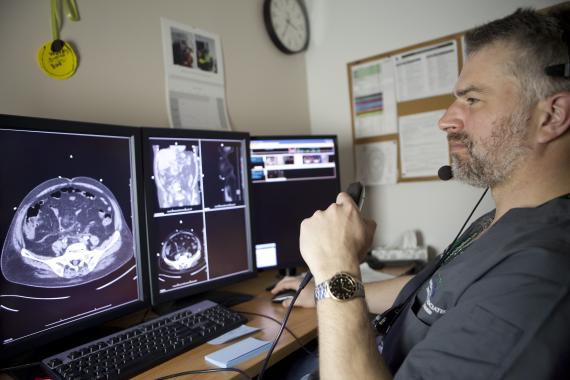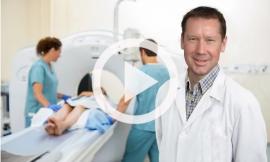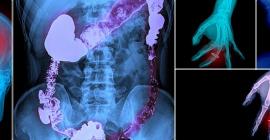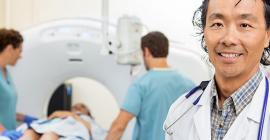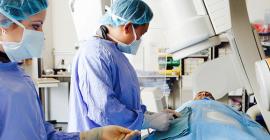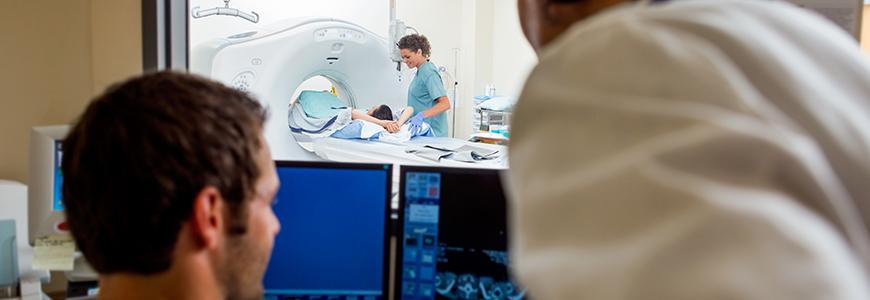
Computer Tomography (CT)
CT scans are much more detailed than regular X-Rays and can identify many conditions that can escape detection on other imaging tests.
A CT Scan, “Computerized Tomogram” or CAT scan is a non-invasive medical test that helps physicians diagnose and treat medical conditions, that may not be visible on other types of medical studies by using advanced x-ray technology to take pictures of your body.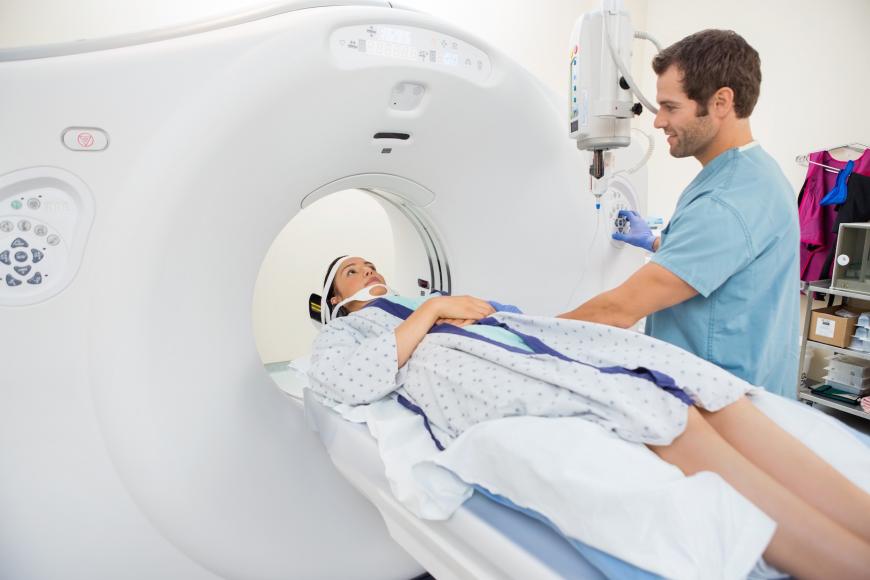
What does a CT Scan look like?
- A CT scanner is a doughnut shaped machine (known as the gantry) that uses advanced x-ray technology to take pictures of your body.
- Immediately after it scans your body, a computer in the scanner reconstructs the data into cross-sectional pictures of your body, called slices or sections.
- CT technology allows radiologists the ability to see more than what a regular x-ray would provide.
- Advanced scanner technology provides images of exceptional quality and lowest possible radiation dose. Lower dose means increased safety for you.
- Higher quality images mean more information for the radiologist to diagnose.
- Following diagnosis a plan can be determined for treatment for your medical condition.
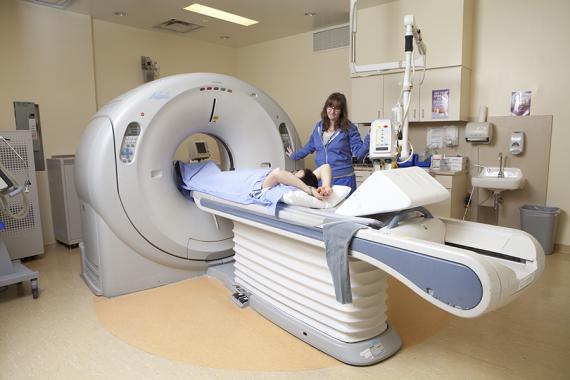
Preparing for CT Scan?
- The patient lies still on a table that can move up or down, and slide into and out from the center of the ring.
- Within the machine, an x-ray tube on a rotating gantry moves around the patient’s body to produce the images, making clicking and whirring noises as the arm moves.
- The technologist will be able to see and speak to the patient, the patient will be alone in the room during the exam.
- Immediately after it scans the patient, a computer in the scanner reconstructs the data into cross-sectional pictures of the body, called slices or sections.
- CT technology allows radiologists the ability to see more than what a regular x-ray would provide.
- Advanced scanner technology provides images of exceptional quality and lowest possible radiation dose.
How does the CT Scanner work?
- CT scanning works very much like other x-ray examinations.
- Very small, controlled amounts of x-ray radiation are passed through the body, while different tissues absorb the radiation at different rates.
- With plain x-rays, when special film is exposed to the absorbed x-rays, an image of the inside of the body is captured. With CT, the film is replaced by an array of detectors, which measure the x-ray profile.
- Inside the CT scanner is a rotating gantry that has an x-ray tube mounted on one side and an arc-shaped detector mounted on the opposite side.
- During each full rotation, as the fan-shaped x-ray beam is emitted through the patient’s body, an image of a thin section is acquired.
- The detector records about 1,000 images-or profiles-of the expanded x-ray beam with each rotation.
- The profiles are then reconstructed by a dedicated computer into two-dimensional images of the sections that were scanned.
- Multiple computers are typically used to control the entire CT system.
- You might think of it as looking into a loaf of bread by cutting the bread into thin slices.
- When the image slices are reassembled by computer, the result is a very detailed, multidimensional view of the body’s interior.
What should I eat or drink?
- You may be asked not to eat or drink anything for several hours beforehand, especially if a contrast material is going to be used in your exam.
- You should inform your physician of any medications you are taking and if you have any allergies. If you have a known allergy to contrast material, your doctor may prescribe medications to reduce the risk of an allergic reaction.
- Inform your doctor of any recent illnesses or other medical conditions, such as a history of heart disease, asthma, diabetes, kidney disease, or thyroid problems.
- Any of these conditions may increase the risk of an unusual adverse effect.
What if I am allergic to IV contrast material?
- If you think you may be allergic to IV contrast material or have experienced a prior reaction to IV contrast material, please notify your referring physician prior to scheduling your CT scan appointment.
- If you have a known allergy to contrast material, your doctor may prescribe medications to reduce the risk of an allergic reaction.
What should I wear?
- You should wear comfortable, loose-fitting clothing to your exam.
- Certain exams may require you to wear a gown, which will be provided.
- Metal objects including jewelry, eyeglasses, dentures, and hairpins may affect the CT images and should be left at home or removed prior to your exam.
- You may also be asked to remove hearing aids and removable dental work.
I am claustrophobic, will I be able to have a scan?
- That shouldn’t be a problem. A CT Scanner is an open machine not a tunnel like an MRI scanner.
- You are not enclosed in the scanner and, as a result, you see completely around yourself.
Will I have to drink something for my scan and why?
- Some abdominal CT scans require the administration of water or oral contrast material to allow the radiologist to evaluate your bowel and also to separate bowel from other important structures.
- Oral contrast materials may be made with barium or iodine. Barium-based contrast material is a thick white flavored drink similar to a milk shake. Iodine-based contrast material is a concentrate mixed with water or juice.
- For optimal imaging, approximately one liter of oral contrast material should be consumed during the hour prior to your scan. If you are having a CT scan of your abdomen or pelvis, you will need to arrive 1 hour before your appointment.
- In some medical conditions and types of study, you may be asked to drink one bottle of barium sulfate at bedtime the night before the study.
What if I might be pregnant?
- Women should always inform their physician and the CT technologist if there is any possibility that they are pregnant.
Will I need an IV (Intravenous) for CT scan?
- Your physician and the radiologist will determine if IV contrast material will be needed for your CT scan.
- IV contrast material containing iodine is used to highlight organs and blood vessels that are otherwise difficult to visualize.
- If IV contrast material is required for your CT scan, a small IV will be placed in your arm or hand prior to the CT scan.
During your CT Scan
- A CT Technologist will take you into the CT Scanner room. Here, you will be positioned on the table which will move into the gantry or doughnut of the CT Scanner.
- At this point, the CT technologist will exit the room.
- Through an intercom system, you and the technologist will always be able to speak with one another.
After your CT scan
- Once your scan is completed, you may resume your regular diet and activities.
- We recommend that you drink plenty of non-alcoholic, decaffeinated fluids, such as water or juice, to help your body flush out any IV or oral contrast material.
How will I know the results of my CT scan?
- After your CT scan, a subspecialized radiologist will read the images and dictate a report that will be sent to your doctor, who will contact you with the results.
